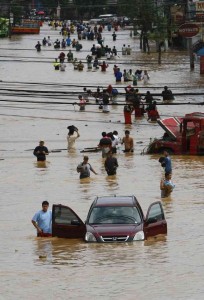Ondoy’s legacy

Ferman Lao, a popular car repair and performance tuning expert, could easily take in up to 15 cars a day in his Speedlab shop in Quezon City.
But then, the wettest of all typhoons struck on the early morning of Sept. 26, 2009. When “Ondoy” finally exited the Philippines, an estimated 14,000 motor vehicles were damaged by the floods. In the following days, Lao was inundated with requests for repairs for flooded and submerged cars. His shop began to look like a refugee camp for cars all muddied up, its electronic boxes and electrical circuits fried by the floods.
Ondoy made Lao a busier, albeit more frustrated, car repair guy. “For months, we were only able to repair less than 50 cars. Yet, every day, my shop was filled up by up to 20 cars damaged by Ondoy, leaving us very little space to do other repairs for other clients. A submerged car costs so much more and takes much more time to fix than anything else caused by normal wear and tear. We were advising customers that they were much better off replacing the entire vehicle,” Lao explained.
In a costly manner, Ondoy was a “wake up call” for the Filipino motorists. The immediate reaction has been the sharp increase in the takeup of car insurance policies.
The Philippine Insurers and Reinsurers Association (Pira), in its 2011 Fact Book, revealed that total premiums availed of for non-life products grew by 8.51 percent in 2010, the year after Ondoy. The growth is considered significant, given that the non-life insurance industry grew less than a percent in 2008. According to Pira, the total premiums signed in for motor vehicle insurance rose to P13.5 billion in 2010, up by 11.4 percent from 2009.
Higher-clearance cars
In 2010, the automotive industry set an all-time high of 168,490 brand-new units sold, eclipsing the previous record of 162,000 set in 1996.
Arlan Reyes, Mitsubishi Motors Philippines Corp. manager, and former Chamber of Automotive Manufacturers of the Philippines Inc. (Campi) president Elizabeth H. Lee attributed the spike in sales to the 2010 presidential election season.
But perhaps Ondoy had a hand, as well, in motivating car buyers to opt for brand-new cars. Noticeable in the 2010 car sales was the increased preference by buyers for higher ground clearance vehicles, which include commercial vehicles, sport utility vehicles (SUVs) and Asian utility vehicles (AUVs). The sales of commercial vehicles (which include vans) grew by 27.4 percent. Light commercial vehicles, which include the pick-ups, grew 32.3 percent. AUVs likewise grew by 21.9 percent.
Lao observed that “buyers prioritized taller vehicles more after Ondoy.”
This year, the typhoon season is far from over, as evidenced by the recent pass of Typhoon “Pedring” over Central and Northern Luzon early this week. Every tropical cyclone now also brings with it the specter of an Ondoy-type destruction in its wake.
Ondoy has also left its mark on the second-hand car industry. When many of the thousands upon thousands of vehicles damaged by Ondoy were put up for sale, apprehensions arose over whether these vehicles salvaged from the floods were still roadworthy.
Car experts then shared their tips on determining when a vehicle had been damaged by floods. They were sound advice two years ago. They still are today. Here are some of the more crucial ones:
1) The smell. The musty odor of a flooded interior may still linger even in a detailed car.
2) The rust. Rust at the small steel/metal and dashboard brackets as well as the brackets of the steering column betray water immersion.
3) The dust and dirt. Look closely at the interior. Look at the gauges and instrumentation panel. Do they look cloudy or dusty from the inside? That may mean moisture or dirt have penetrated the gauges.
4) The stains. Inspect the engine bay area and other hidden portions of the vehicle such as the firewalling, rack and pinion, and the upper part of the cross member, and look for water and mud stains, which leave a distinctive mark.
5) The circuits. Look under the dashboard. Check if there are missing air con duct systems or wires not routed properly. Look if there are no rubber covers on the steering column where it goes through the firewall.
6) The crucial parts. Water will do the most damage to the following key parts of a car, so look out for them first when you suspect a car has been submerged in floods: Electric Power Steering (for cars installed with EPS), ECUs of airbags and other safety components, electrical wiring on the flooring, stick shift bushings located in the flooring, automatic transmission mechanism, handbrakes/footbrakes on vehicles with drum brakes, drum brakes and brake pads, wiring harness and fuse box underneath the dashboard.
